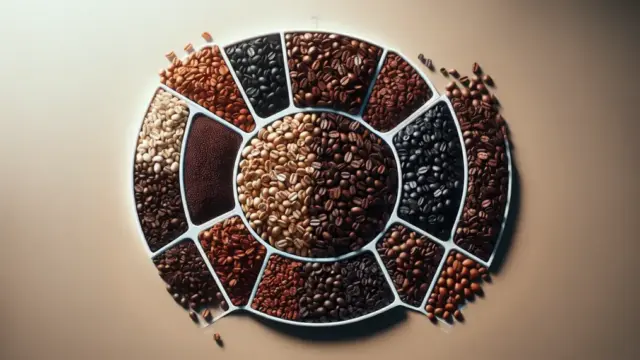Discovering the world of coffee can be an exciting journey, especially when you start to understand the origins of coffee beans. Each variety tells a unique story, shaped by the climate and soil of its native region. As you sip your favorite brew, have you ever wondered where those beans came from and what makes them special?
In this beginner’s guide, we will explore the captivating origins of coffee beans from different parts of the world. From the vibrant flavors of African coffee to the distinct profiles of Central and South American varieties, there’s so much to discover. Understanding these origins not only enhances your appreciation of coffee but also helps you make informed choices when selecting beans.
Choosing the right coffee beans can feel overwhelming, especially with so many options available. We’ll break down the essential factors to consider, such as roast levels and the balance of acidity and bitterness. With a little guidance, you’ll be well-equipped to find the perfect beans that suit your taste.
Lastly, proper storage is key to maintaining the freshness and flavor of your coffee. We’ll discuss effective techniques that keep your beans at their best and weigh the pros and cons of freezing coffee. By the end of this guide, you’ll be ready to elevate your coffee experience to new heights!
- Explore the unique characteristics of coffee beans from different origins.
- Learn how to choose the perfect beans based on roast levels and flavor balance.
- Discover essential storage tips to keep your coffee fresh and flavorful.
Origins of Coffee Beans and Their Characteristics
The Charm of African Coffee Beans
When you think about coffee and its origins, Africa often comes to mind first. This continent is celebrated for producing some of the most distinct coffee beans in the world. Ethiopian coffee, for instance, is known for its bright acidity and floral notes, which reflect the unique climate and rich soil of the region. The high elevations and varied microclimates contribute to the complex flavor profiles that make African coffee so special.
Another notable region is Kenya, where coffee beans are grown at high altitudes, resulting in a crisp and fruity flavor. The unique processing methods used in Africa, such as washing and sun-drying, also enhance the beans’ characteristics. Understanding these factors allows you to appreciate the diverse flavors that African coffees bring to your cup.
By exploring different African coffee varieties, you’ll discover a world of flavors that can elevate your coffee experience. From the vibrant and fruity notes of Ethiopian beans to the bold and rich flavors of Kenyan coffee, there’s so much to enjoy.
- Ethiopian coffee is known for its bright acidity and floral notes.
- Kenyan coffee beans often have a crisp and fruity flavor due to high-altitude growth.
- The unique processing methods enhance the characteristics of African coffee.
The Uniqueness of Central and South American Coffee Beans
Moving on to Central and South America, these regions offer coffee beans that are equally captivating but different from their African counterparts. For example, Guatemalan coffee is often characterized by its full body and chocolatey undertones. The volcanic soil in Guatemala plays a significant role in developing these rich flavors.
In Brazil, the largest coffee producer globally, beans are typically smooth with nutty and sweet notes. The country’s diverse climate allows for various coffee styles, from espresso to lighter brewed options. Understanding these regional differences helps you navigate the vast world of coffee beans and choose the ones that suit your palate.
As you delve deeper into the origins of these beans, you’ll find that each region has its own story to tell. This journey not only enriches your coffee knowledge but also enhances your overall enjoyment of this beloved beverage.

If you found the exploration of African and Central American coffee beans intriguing, you might also appreciate our article on Your Ultimate Guide to Enjoying Coffee: From Beans to Tools for Beginners!. This guide offers a comprehensive overview of selecting, brewing, and storing coffee, which can enhance your coffee experience even further.
- Guatemalan coffee is known for its full body and chocolatey undertones.
- Brazilian coffee beans are typically smooth with nutty and sweet notes.
- Each region’s unique climate and soil contribute to the flavor profiles of their coffee beans.
2. How to Choose Coffee Beans
Understanding Roast Levels
When it comes to selecting coffee beans, understanding roast levels is crucial. The roast level significantly influences the flavor profile of your coffee. Light roasts are known for their bright, fruity flavors and higher acidity, which can highlight the unique characteristics of the beans’ origin. On the other hand, medium roasts strike a balance, bringing out a mix of acidity and sweetness, making them a popular choice among many coffee lovers.
Dark roasts, in contrast, tend to have a bolder, richer flavor with a lower acidity. The beans develop deeper chocolatey and smoky notes during the roasting process. It’s important to consider your personal preferences when choosing a roast level. Are you someone who enjoys the vibrant notes of a light roast, or do you lean more towards the robust flavors of a dark roast? Finding the right roast for your taste can transform your coffee experience.
Additionally, the freshness of the beans plays a vital role. Freshly roasted beans will always yield a more flavorful cup. Look for roast dates on packaging to ensure you’re getting the best quality beans available. Understanding these nuances will help you navigate the vast coffee landscape and choose beans that suit your palate.
- Light roasts offer bright, fruity flavors with higher acidity.
- Medium roasts provide a balance of acidity and sweetness.
- Dark roasts deliver bold, rich flavors with lower acidity.
Balancing Acidity and Bitterness
As you choose your coffee beans, it’s essential to find a balance between acidity and bitterness. Acidity in coffee can enhance the flavor and give it a lively character, while bitterness adds depth. However, too much bitterness can overwhelm the palate, so finding that sweet spot is key.
Different beans have varying levels of acidity and bitterness based on their origin and roast. For instance, Ethiopian beans are typically more acidic, while Brazilian beans tend to be smoother and less bitter. Experimenting with different origins and roast levels can help you discover what combination works best for you.
By understanding how acidity and bitterness work together, you can create a well-rounded cup of coffee that suits your taste. Remember, the journey is all about exploration and finding what you love. Don’t be afraid to try new beans and roasts as you refine your preferences.
- The right balance between acidity and bitterness enhances your coffee experience.
- Ethiopian beans are often more acidic, while Brazilian beans are smoother.
- Experimenting with different origins helps you find your ideal flavor profile.
3. Roasting Techniques and Coffee Flavor
How Roasting Affects Flavor
Roasting coffee beans is a fascinating process that plays a crucial role in determining the final flavor of your coffee. When beans are roasted, they undergo a series of chemical changes that develop distinct flavors and aromas. The length and temperature of the roasting process can greatly influence the taste profile. For example, a short roast at a lower temperature typically preserves the beans’ original characteristics, resulting in a brighter and more acidic cup.
On the other hand, longer roasting times at higher temperatures tend to produce bolder flavors, often with deeper, chocolatey notes. This is where the choice of roast level becomes essential. If you’re someone who enjoys exploring a wide range of flavors, understanding how roasting affects the beans can help you make more informed decisions when selecting your coffee.
Moreover, the origin of the beans also interacts with the roasting process. Beans from different regions respond uniquely to heat, and their innate flavors can be enhanced or muted depending on how they are roasted. For instance, Ethiopian coffee, known for its fruity and floral notes, can lose some of its brightness if roasted too dark.
As you delve deeper into the world of coffee, take time to experiment with various roast levels and see how they transform the flavors in your cup. The journey of discovering the perfect roast can lead to a richer coffee experience that resonates with your taste.
- Roasting time and temperature are key to flavor development.
- Light roasts preserve original bean characteristics, while dark roasts enhance boldness.
- Different origins interact uniquely with the roasting process.
Home Roasting Methods
If you’re feeling adventurous, home roasting can be an exciting way to take your coffee experience to the next level. There are several methods you can try, from simple stovetop techniques to specialized home roasting machines. For instance, using a popcorn maker can be a fun and accessible way to start roasting your beans. This method allows you to monitor the roast closely and adjust as needed to achieve your desired flavor profile.
Another popular method is the oven roast, where you spread green coffee beans on a baking sheet and roast them in the oven. This method requires careful attention, as it can be easy to over-roast if you’re not watching closely. Regardless of the method you choose, the key is to experiment and find out what works best for you.
Roasting your beans at home not only allows you to customize flavors but also brings the experience full circle, connecting you with the origins of your coffee in a whole new way. With a little practice, you’ll be able to create unique blends that reflect your personal taste and make every cup a delightful adventure.

If you’re intrigued by the art of coffee roasting, you might also appreciate the insights shared in the article Discover the Allure of Light Roasted Coffee! Your Guide to Choosing, Brewing, and Storing. This piece dives into the unique characteristics of light-roasted coffee, offering tips on how to select, brew, and store it to enhance your coffee experience.
- Home roasting can be done using popcorn makers or ovens.
- Experimenting with different methods leads to unique flavor profiles.
- Roasting at home connects you directly to the coffee-making process.
4. Importance of Proper Storage
Techniques for Keeping Freshness
As you continue to explore the world of coffee, it’s essential to think about how to store your beans properly. The way you store your coffee can have a significant impact on the flavors and freshness of your brew. One key factor is to keep your beans in an airtight container. This helps prevent exposure to air, which can lead to oxidation and loss of flavor over time.
Another important consideration is to store your coffee beans in a cool, dark place. Light and heat can degrade the quality of the beans, so it’s best to avoid storing them near the stove or in direct sunlight. Utilizing a pantry or a cabinet can be an excellent choice for maintaining optimal conditions for your coffee. By taking these simple steps, you can enjoy a fresher and more flavorful cup every time you brew.
- Use an airtight container to minimize air exposure.
- Keep beans in a cool, dark place to avoid degradation.
- Regularly check the freshness of your coffee supply.
Pros and Cons of Freezing Coffee Beans
The concept of freezing coffee beans can be a bit controversial among coffee enthusiasts. On one hand, freezing can extend the shelf life of your beans and preserve their freshness for a longer period. If you find a particular bean you love, buying in bulk and freezing some can be a smart way to ensure you always have it on hand. Just make sure to use an airtight container to prevent moisture from affecting the beans.
However, there are some downsides to consider. When you take frozen beans out to use them, they can experience condensation, which may alter their flavor. Additionally, if you freeze and thaw your beans multiple times, this can lead to a decline in quality. It’s important to evaluate your coffee habits and decide whether freezing is the right choice for you. Ultimately, the key is to find a storage method that keeps your coffee tasting great while fitting into your lifestyle.
By understanding the pros and cons of freezing, along with the best techniques for keeping your beans fresh, you can make informed decisions that enhance your coffee experience. Remember, the journey of coffee appreciation continues even after you’ve selected the perfect beans.

If you found the insights on coffee storage helpful, you might also enjoy our article on how to choose the right coffee beans. In Mastering Coffee at Home! Easy Tips for Beginners on Bean Selection and Brewing, we provide accessible tips for selecting beans and brewing at home, perfect for enhancing your coffee experience.
- Freezing can extend the shelf life and preserve freshness.
- Ensure airtight storage to avoid moisture when freezing.
- Repeated freezing and thawing may degrade quality.
Summary
As we wrap up our exploration of coffee, it’s clear that understanding the origins of coffee beans plays a significant role in enhancing your coffee experience. From the vibrant flavors of African coffee to the unique profiles of Central and South American varieties, each bean tells a story that reflects its native land. Knowing where your coffee comes from not only enriches your appreciation but also helps you choose beans that align with your taste preferences.
In addition to the origins, factors like roast levels, acidity, bitterness, and proper storage techniques are crucial for enjoying a delightful cup of coffee. As you continue your coffee journey, remember to experiment with different beans and brewing methods to discover what resonates with you. Embrace the adventure of coffee appreciation and let each cup bring you joy.
- Understanding the origins of coffee beans enriches your appreciation.
- Roast levels and flavor balance are essential for selecting the right coffee.
- Proper storage techniques help maintain the freshness and flavor of your beans.
I would love to hear your thoughts! What are your favorite coffee beans or brewing methods? Share your experiences in the comments below!
































































Comment